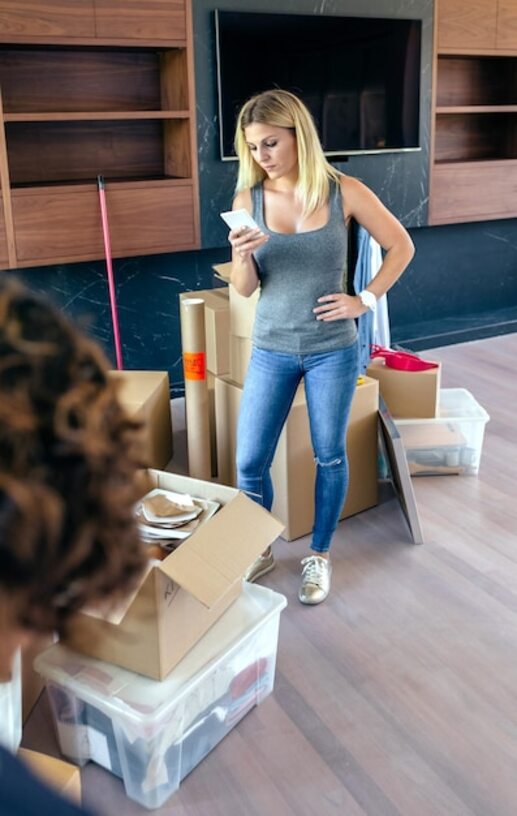How to optimize your move with creative and practical solutions

Optimizing your move not only saves time and money but also transforms a stressful process into a pleasant experience. In this article, you will discover creative and practical solutions that will help you plan every detail of your move efficiently. From choosing the right transportation to tips for packing smartly, every step matters to ensure that your transition to a new home is as smooth as possible. Get ready to become the master of your own move.
1. Advance planning: The secret to a stress-free move
The key to a successful move lies in early planning. Starting in advance allows you to evaluate every aspect of the process, from organizing your belongings to the logistics of transportation. Creating a detailed inventory of what you have and deciding what to keep, sell, or donate not only simplifies packing but can also reduce costs and effort in the future. By establishing a timeline with deadlines for each task, such as hiring moving services and packing specific rooms, you will transform a potential chaos into a controlled and efficient flow.
In addition, early planning gives you the opportunity to research creative solutions that can make your move more practical. For example, consider using reusable boxes or plastic containers that are not only more durable but can also be used in your new home for long-term storage. Likewise, you can involve friends and family in the process through a "packing party," where everyone collaborates while enjoying time together. This way, you will turn a tedious task into a fun social activity, thus alleviating any emotional burden associated with leaving behind a beloved home.
2. Choosing the ideal transport service: Moving truck or van?
When planning your move, one of the most crucial aspects is choosing the right transportation service. The decision between a moving truck or a van will largely depend on the volume and nature of your belongings. If you have large furniture, appliances, or a significant number of boxes, opting for a moving truck may be the best choice, as these vehicles are designed to handle bulky and heavy loads, ensuring everything arrives at your new home in one trip. Additionally, many services offer extra options such as labor for loading and unloading, which can relieve a considerable amount of physical work. On the other hand, if your move only includes a few items or if you live in a smaller space like an apartment, a van might be sufficient. This type of vehicle is easier to maneuver and park in congested urban areas, and it is generally more economical in terms of rental and fuel consumption. Also consider factors such as the distance of the move and the time available; if you are in a hurry to relocate or if you are in an area where traffic can be complicated, choosing the right means could make the difference between a stressful experience and a much smoother one. Carefully assess your specific needs to make the decision that best fits your circumstances.
3. Innovative packaging materials: Beyond cardboard
When it comes to moving, packing is one of the most crucial aspects to ensure that your belongings arrive at their destination in perfect condition. However, traditional cardboard, while useful, is not always the most efficient or sustainable option. That's why more and more people are choosing innovative packing materials that not only protect their items but are also environmentally friendly. From reusable boxes and bioplastics to solutions based on recycled paper and biodegradable wraps, there are a variety of alternatives that can make your move more efficient and aligned with sustainable practices.
In addition to being eco-friendly, these innovative materials offer additional advantages such as greater durability and versatility. For example, reusable boxes allow for secure storage without generating unnecessary waste; furthermore, many of them are stackable and easy to transport. Other options like air bubbles made of paper or padded pads made from natural fibers provide excellent protection for fragile items without resorting to conventional plastic. By considering these alternatives during your move, you will not only optimize the logistical process but also contribute to a more sustainable and responsible future in waste management.
4. Efficient packaging techniques: How to maximize space
To maximize space during your move, it is essential to employ packing techniques that allow you to optimize every corner of your boxes and suitcases. An effective strategy is to use the rolling method for clothing instead of folding it; this not only reduces wrinkles but also makes better use of the available space. Additionally, consider filling the gaps inside the boxes with smaller items, such as shoes or accessories, to prevent items from shifting during transport. Every centimeter counts, and a clever approach can make a difference in the number of boxes you need.
Another useful trick is to sort your belongings by categories before packing them. Grouping similar items not only makes the unpacking process easier, but it also helps you identify which items can be stacked together without risk of damage. Use sturdy boxes and make sure to label them clearly; this will allow for quick access to what you need without having to open every box. Also remember to consider alternatives to conventional cardboard, such as stackable plastic containers, which are durable and make the most of vertical space in your vehicle or moving truck. With these effective techniques, your move will be more organized and less stressful.
5. Get rid of the clutter: The importance of purging before moving.
Getting rid of clutter is a crucial step before any move, and purging unnecessary items not only makes the process easier but also allows you to start your new life with a more organized and burden-free space. Before packing your belongings, take some time to assess which items you really need and which have been gathering dust in the corners of your home. From clothes you haven't worn in years to appliances that are no longer functioning, each item you decide to eliminate will bring you closer to a more efficient and less overwhelming move. Additionally, this process can be freeing; letting go of the old opens up space for the new and fosters a more minimalist mindset.
The purge also provides the perfect opportunity to consider sustainable alternatives to disposing of items. You can donate items in good condition to local organizations or sell them online, which not only helps you reduce the volume of things you need to transport but can also generate extra income to fund your move. Moreover, this act of generosity can benefit others and positively contribute to your community. At the end of the day, getting rid of clutter not only streamlines your move but also transforms the act itself into a meaningful and reflective experience.
6. Smart labeling: Makes unpacking in your new home easier
Smart labeling is a key strategy to facilitate unpacking in your new home. By using a clear and organized labeling system, you can quickly identify the contents of each box without the need to open them one by one. Choose color-coded labels, where each color represents a specific room, or use an alphanumeric code that you can record on a list. This way, you not only save time while unpacking but also minimize the frustration and initial clutter that can arise when moving into a new space.
Additionally, consider including brief notes on the labels about the essential items within each box. For example, if you have kitchen utensils mixed with other household items, note "kitchen – utensils" to facilitate immediate location. This practice will allow you to focus on what’s most important upon arriving at your new home and avoid awkward moments searching for that frying pan or the phone charger just when you need it most. With efficient labeling, your unpacking process will become a structured and less overwhelming task, allowing you to enjoy your new environment more quickly.
7. Technological solutions to organize your move
In the digital age, technological solutions can be your best allies for organizing a move without setbacks. There are specific applications that allow you to keep detailed control of your belongings, facilitating inventory and ensuring that nothing is left behind. These tools not only help you classify and label boxes, but you can also schedule reminders for key tasks in the moving process, such as canceling services or notifying address changes. This way, you can focus on what matters while technology takes care of the tracking.
In addition to mobile applications, other technological tools such as project management platforms can be useful for coordinating activities among friends or family who will help you with the move. You can create shared lists where each person can see what tasks they need to complete and when, allowing for better organization and collaboration. It is also possible to use interactive maps to plan efficient routes to your new home or even hire professional services through specialized websites that facilitate the search and comparison of transportation options. Incorporating these technological solutions not only simplifies the logistical process but can also add a fun touch to a normally stressful task.
8. Final tips for a successful and smooth moving day.
To ensure your moving day is successful and smooth, it is essential to have a clear and well-structured plan. Start by creating a checklist with all the pending tasks, from disconnection of services to the final cleaning of the old place. Assign specific times for each activity and make sure to have the necessary help, whether from friends, family, or professionals. Communication is key; ensure that everyone involved knows their role and schedule to avoid confusion on moving day.
Another crucial aspect is to stay calm during the process. It’s easy to get overwhelmed by stress when things don’t go as expected, but remember that a positive approach can make a difference. Make sure to have an essential kit with basic items (like water, snacks, important documents, and tools) to facilitate any unforeseen events. Finally, upon arriving at your new home, take a moment to breathe and celebrate this new beginning before diving into the unpacking process. With these final tips, you will be prepared to face your move with confidence and optimism.



